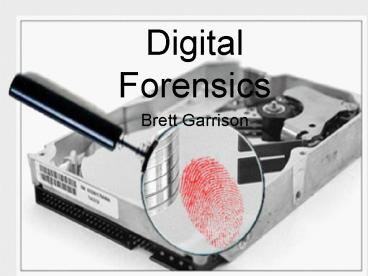Digital Forensics - PowerPoint PPT Presentation
1 / 17
Title:
Digital Forensics
Description:
Digital Forensics Brett Garrison Quick Facts More than 90% of today s information is created and stored or processed electronically. More than 70% are never printed ... – PowerPoint PPT presentation
Number of Views:532
Avg rating:5.0/5.0
Title: Digital Forensics
1
Digital Forensics
- Brett Garrison
2
Quick Facts
- More than 90 of todays information is created
and stored or processed electronically. - More than 70 are never printed or produced into
a hard copy - Information can be erased, moved around, or
hidden with ease. - A good forensic examiner can restore or find this
missing information.
3
Definition
- Using computer science to aid in the legal
process and to conduct investigations. - Gathering data for evidence
- Aid police investigations
- Recover data
- Provide testimony in court
- Gather any other information that can be found on
a digital or electronic media. - Information gathered can be audio, video, or
graphical.
4
Devices
- Computer systems
- PDAs
- Cell phones
- USB drives
- CD-ROMs
- Laptops
- Any other storage media
5
When is digital forensics used?
- Property disputes
- Contract disputes
- Fraud or embezzlement
- Wrongful termination
- Sexual harassment suits
- Medical malpractice
6
What do they do?
- Forensics experts extract both visible and
invisible computer data. - More than simply data recovery
- Locate data throughout the system
- Recover data
- Responsible for maintaining the integrity of the
information found, preventing damage, data
corruption, or virus exposure. (All data must be
acceptable for use in a court of law.) - Results of forensic investigation must be
reproducible in such a way that the information
is authenticated and reliable - Work closely with law enforcement, government
officials, and attorneys. - Must be well-versed in relevant case law.
7
Data Recovery
- A skilled forensic worker can recover all of the
files on a computer or storage device. - Active files
- Invisible files
- Deleted but remaining files
- Hidden files
- Encrypted files
- Pass-word protected files
- Most information that is gathered is undetectable
or unviewable to the average computer user.
8
Data Recovered
- Digital forensic practitioners are generally
concerned with three types of data - Active data information that is readily
available and easily accessed on the computer.
Ex Programs, files, and other data used by the
operating system. - Archival data data that has been backed up and
stored. Ex hard disks, cds, USB drives - Latent or Ambient data data that requires
special tools or skills to retrieve. Ex data
that has been overwritten or deleted
9
Steps for Investigating an Electronic Device
- Step 1
- All files that have been deleted or have not yet
been overwritten are recovered. - Computers constantly write data to the hard drive
when in use. The operating system over writes
data on the hard drive that is no longer needed
or used. - This data can be retrieved if not completely
overwritten.
10
Step 2
- All data found in special or inaccessible areas
of the device are analyzed. - Areas of disk that are not currently in use, but
have had data previously stored on them. - Slack Space- unused space at end of file where
previously created information could be stored
11
Final Step
- Report the analysis of the device or system
- Provide copies of data collected
- Arranged into support for legal theories or
strategies. - Often provide expert testimony or advice when
necessary.
12
Tools Used
- Light analyzers
- Tools that analyze lighting allow forensics
practitioners to determine if a photo has been
tampered with - Win Hex
- Data Recovery
- Microsoft Log Parser
- Extract information of almost any format
- PMDump
- Dumps memory contents of a process into a file
without stopping the procedure (Windows).
13
Famous Cases Solved with Digital Forensics
- Chandra Levy
- Last seen alive on April 23, 2001
- Digital forensics lead to the discovery that
someone had conducted an internet search for Rock
Creek Parks Klingle Mansion, near Washington,
D.C. - Police scoured the area and a man walking his dog
found Levys remains on May 22, 2002,
approximately one year later, confirming that
the case was in fact a homicide.
14
Famous Cases
- Dennis Rader
- Known as BTK killer in Wichita, KS area.
- Murdered 10 people between 1974 and 1991.
- Communicated with police through letters for
years. Sent a message on a floppy disk in
February 2005. - Examination of the disks properties revealed the
words Dennis and Christ Lutheran Church. - DNA tests confirmed him a match and he was
arrested 9 days later. - Rader was planning his first murder since 1991.
15
Conclusion
- Digital forensics is a very high tech field
- Can be expensive
- Has immense potential in law enforcement, and
especially in the future of law enforcement. - Field grows in leaps and bounds every day.
16
Sources
- http//www.evestigate.com/
- http//www.digitaldataforensics.com/
- http//www.wikipedia.org/
- http//digg.com/software/
17
- Questions?































